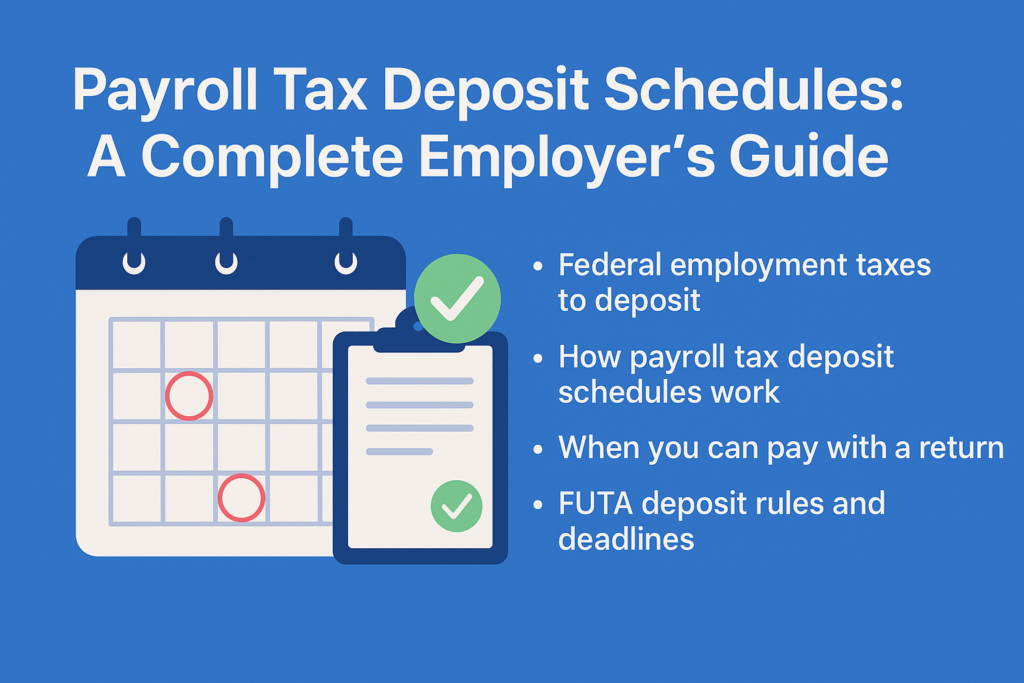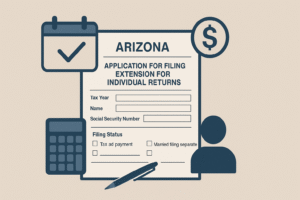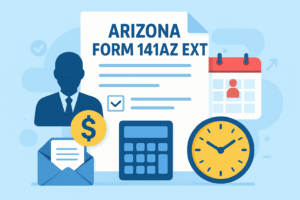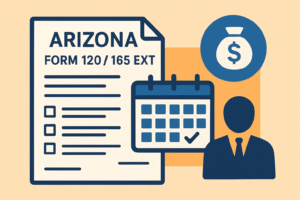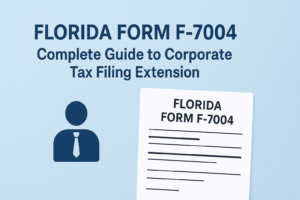Every employer has a legal responsibility to withhold and deposit employment taxes on time. But how often should you deposit them? And what if your liability is small enough to simply pay with the return?
In this guide, you’ll learn:
- What federal employment taxes you need to deposit
- How payroll tax deposit schedules work
- When you can pay with a return (Form 940, 941, 943, 944, 945)
- FUTA deposit rules
- Deposit deadlines and payment methods
- Common questions and clear examples
Let’s dive in.
What Are the Federal Employment Taxes?
Here are the four primary types of federal employment taxes:
1. Federal Income Tax
Withheld from employee pay based on Form W-4. There’s no fixed percentage—it varies by income and filing status.
2. FICA Tax
Split between the employer and employee:
- Social Security: 6.2% each
- Medicare: 1.45% each
3. Additional Medicare Tax
Applies to employees earning over $200,000 annually. Employers must withhold an additional 0.9% once wages cross this threshold (but don’t match it).
4. FUTA Tax (Federal Unemployment Tax)
Paid only by employers. The base rate is 6.0% on the first $7,000 of each employee’s wages, but most receive a credit of up to 5.4%, reducing it to 0.6%.
Payroll Tax Deposit Schedules for Income and FICA Taxes
The IRS assigns you a monthly or semiweekly deposit schedule based on your tax liability during the lookback period (explained in FAQs).
1. Monthly Depositor
- If your tax liability is $50,000 or less during the lookback period.
- Deadline: 15th of the following month.
Example: Taxes withheld in June are due by July 15.
2. Semiweekly Depositor
- If your tax liability is more than $50,000 during the lookback period.
- Deadlines:
- Payday on Wed–Fri → Deposit by next Wednesday
- Payday on Sat–Tues → Deposit by next Friday
Quick Tip:
Always go by the payday, not the pay period.
3. $100,000 Next-Day Rule
If your accumulated tax liability reaches $100,000 on any day, you must deposit the full amount by the next business day, no matter your usual deposit schedule.
Payroll Tax Deposit Schedule for FUTA Tax
FUTA taxes aren’t deposited with each payroll. Instead, they follow a quarterly schedule, only when liability exceeds $500 for the quarter.
FUTA Deposit Deadlines:
| Quarter | Quarter Ends | Deposit Due By |
| Q1 | March 31 | April 30 |
| Q2 | June 30 | July 31 |
| Q3 | September 30 | October 31 |
| Q4 | December 31 | January 31 |
If total FUTA tax is $500 or less for the year, you may be able to pay with your Form 940 return instead of making deposits.
💬 Payment with Return (When You Don’t Need to Deposit)
In some cases, if your tax liability is small, you can pay taxes when filing the return, skipping separate deposits.
Here’s how this applies to each employment tax form:
Form 941 – Quarterly Payroll Tax
- Pay with return if total liability for the quarter is less than $2,500.
Form 944 – Annual Payroll Tax
- Pay with return if annual liability is under $2,500.
- You must be notified by the IRS to file this form instead of Form 941.
Form 940 – Annual FUTA Tax
- Pay with return if total FUTA tax is $500 or less for the year.
- If over $500, deposit quarterly.
Form 943 – Agricultural Payroll
- If annual liability is under $2,500, payment with return is allowed.
Form 945 – Nonpayroll Withholding
- Applies to pensions, gambling, backup withholding, etc.
- Pay with return if annual liability is under $2,500.
✅ Summary: Payment with Return Thresholds
| Form | Type of Tax | Pay with Return If Liability Is |
| 941 | Quarterly payroll tax | Less than $2,500 (per quarter) |
| 944 | Annual payroll tax | Less than $2,500 (per year) |
| 940 | FUTA | $500 or less (per year) |
| 943 | Agricultural employment | Less than $2,500 (per year) |
| 945 | Nonpayroll withholding | Less than $2,500 (per year) |
Reminder: If liability goes above these thresholds or you accumulate $100,000 on any day, you must deposit electronically.
📅 Payroll Tax Deposit Due Dates Overview
| Schedule Type | When Taxes Are Due |
| Monthly Depositor | 15th of the following month |
| Semiweekly Depositor | Wed/Fri after payday (based on pay date) |
| $100K Next-Day Rule | Next business day after hitting threshold |
| FUTA (over $500) | Last day of month following quarter end |
| Payment with Return | When return is filed (if within threshold) |
💻 How to Deposit Employment Taxes
With one exception, all deposits must be made electronically using the Electronic Federal Tax Payment System (EFTPS).
Employers can choose from the following options:
- EFTPS.gov
Log in and schedule or make one-time payments from your business bank account. - IRS Business Tax Account
Manage balances, see prior filings, and handle deposits across tax types. - EFTPS by Phone
If enrolled, you can also use the automated phone system to submit payments.
Quick Tip:
Schedule your deposits in EFTPS a day or two before the deadline to avoid same-day cutoff issues.
❓Frequently Asked Questions About Payroll Deposit Schedules
What Is the IRS Lookback Period Used For?
The IRS uses the lookback period to determine your deposit schedule for the year.
- For 2025, the lookback period is July 1, 2023 – June 30, 2024.
- If your total tax liability during that time was $50,000 or less, you’re a monthly depositor.
- If it’s more than $50,000, you’re a semiweekly depositor.
How Do I Know if I’m a Monthly or Semiweekly Depositor?
Review your Form 941 filings from the lookback period:
- Add the amounts from Line 12 (tax liability) of each quarter.
- If the total is more than $50,000 → Semiweekly depositor.
- If $50,000 or less → Monthly depositor.
What Is the Semiweekly Depositor Rule?
If you’re a semiweekly depositor, here’s when your taxes are due based on payday:
| Payday | Deposit Due |
| Wednesday–Friday | Following Wednesday |
| Saturday–Tuesday | Following Friday |
✅ Final Thoughts
Understanding payroll tax deposit schedules—and knowing when you can pay with your return—is essential for IRS compliance and avoiding costly penalties. Whether you’re filing quarterly, annually, or just starting out, staying organized and using EFTPS will save time and stress.

